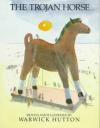Warwick Hutton masterfully retells and illustrates the famous legend of The Trojan Horse. The familiar story is told in child friendly language that provides context to the simple and beautiful watercolor and pen illustrations. For those who may be unfamiliar with the 3000 plus year old legend (or need a refresher as I did), Helen of Sparta and Paris, the son of the King of Troy, fall in love and flee to Troy. The issue at stake is that Helen is already married to the King Menelaus of Sparta. When the Greeks gather an army and travel to Troy to retrieve Helen and wreak revenge, a ten year war begins between the Greeks and the Trojans. “Many battles were fought – and there were many brave heroes – but the armies were equally matched. For weeks, for months, for years, both sides fought, watched, waited, then fought again.” Imagine the Trojans surprise when the Greeks sail away one morning leaving behind an enormous wooden horse. Children will delight in learning how the Greeks won the war by tricking the Trojans with the wonderful horse. In the end, Hutton writes, “[e]veryone had forgotten Paris and Helen, who had started it all. But there in the city square stood the wooden horse, and over the smoking ruins of Troy its bright painted eyes still gazed.”
Curriculum Connections
The ancient Greeks are responsible for a wide variety of contributions to the modern world including: architectural styles, art, legends and myths, many aspects of our democratic government, trial by jury, and the Olympics (3.1)! Pretty impressive! The Trojan Horse is an engaging and perhaps familiar story for a read aloud to introduce a unit on the Ancient Greeks. Teachers can call attention to the geographical features of the Aegean Sea and how water impacted the culture of the Greeks with respect to travel, trade, and war (3.4). The Mycenae-ans were great seamen, warriors, and traders with a respect for beauty as well as function. The architecture of the Trojan wall in Hutton’s drawings demonstrates the use of sculpture to enhance a functional object with beauty. Even the legend itself presents an opportunity to talk about the Greek alphabet and mythology and the ways that this story has been passed down to us today. If used in conjunction with other sources such as the Usborne Book of World History or Every Day Life in the Ancient World, the book can be used to grab the attention and interest of young readers, who may not have as much background knowledge to pull from, in order to share the many contributions of this ancient civilization.
- Greeks at War – Use this file to develop a lesson plan related to the culture and lifestyle of the Greek warriors. Includes great activities to capture the imagination of transitional readers.
- Ancient Timeline – This timeline designed for kids can be used to help highlight the “ancient” in Ancient Greece!
- Greek Quiz – This could be a great pre-activity to determine what background knowledge (if any) students might have.
General Information
- Book: The Trojan Horse
- Author: Warwick Hutton
- Illustrator: Warwick Hutton
- Publisher: Margaret K. McElderry Books
- Publication Date: 1992
- Pages: 32
- Grade Range: K-5
- ISBN: 0689505426

